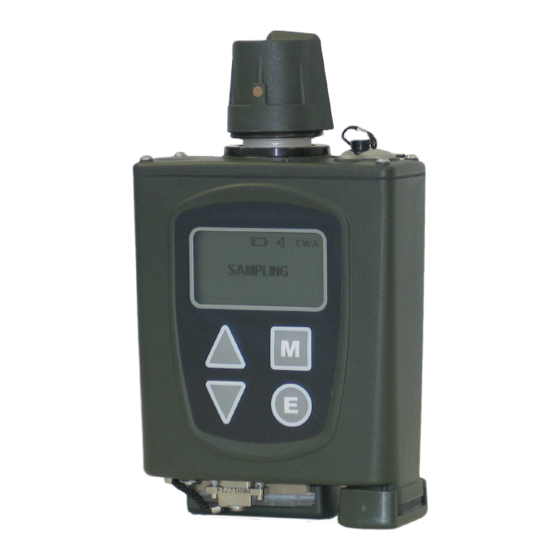
Table of Contents
Advertisement
Advertisement
Table of Contents

Subscribe to Our Youtube Channel
Summary of Contents for Smiths detection LCD 3.3
- Page 2 IDENTIFY ALL COMPONENTS & FEATURES OF THE SMITHS® DETECTION LCD 3.3 DISCUSS OPERATIONAL CAPABILITIES & LIMITATIONS DEMONSTRATE USES & APPLICATIONS DISCUSS CARE & MAINTENANCE ...
- Page 3 The Smiths® LCD 3.3 Lightweight Chemical Detector is a chemical agent detector designed to provide first responders with an effective means of detecting a range of Chemical Warfare Agents (CWA) and Toxic Industrial Chemicals (TICs).
- Page 4 This will replace the Smiths APD 2000 that ® is now assigned to all Quints, USAR & Hazardous Materials units.
- Page 7 1. Press down lightly on the Raincap 2. Rotate counter-clockwise until the ON position is reached. The Raincap will rise, exposing the inlet. 3. Status Light flashes every second 4. Self Test will normally finish within one minute...
- Page 8 Screen at start up. (Warm up approximately one minute) Normal operation Indicates equipment malfunction/fault. (Low battery. Change sieve pack.)
- Page 9 The Status Screen shows Chemicals listed below and their relative concentrations. FRO level personnel will use the LCD 3.3 to detect the presence of CWA’s and TIC’s. If CWA or TIC presence is detected and the LCD 3.3 goes into alarm, FRO personnel should back out and establish exclusion zones appropriately.
- Page 10 Chemicals and agents detected by the LCD 3.3 Toxic Industrial Chemicals (TICs) Chemical Warfare Agents Chlorine GA - Tabun GB - Sarin Hydrogen Sulfide GD - Soman Hydrogen Cyanide GF- Cyclosarin Sulfur Dioxide L - Lewisite ...
- Page 11 Normal operation amber light flashes about once a second. When Chemical warfare agents are present both amber and red lights flash constantly. An audible alarm will sound with the flashing lights.
- Page 12 • Perform confidence test at initial start up • Find confidence test in main menu. • The main menu is accessed by pressing the M button • Press the E button to start the test...
- Page 13 • When indicated apply the confidence tester. Test G then H modes • Once the test is complete, the detector will clear down. Make sure to allow the unit Hold confidence tester to go back to sampling close to, but not touching mode before shutting the inlet.
- Page 14 1.Turn Off Unit by turning 3. Fully withdraw the battery Raincap counter-clockwise. cassette 2. Twist the battery cassette locking cover counter- clockwise 90°...
- Page 15 4. Fit the 4 x AA batteries in correct orientation (refer to the label inside the cassette)
- Page 16 5. Replace battery cassette 6. Twist battery cassette locking cover clockwise 90° to secure cassette Note: Store batteries outside of unit when not in use.
- Page 17 Survey Mode The survey nozzle can be attached to the detector when there is a need to investigate a particular area or location. This mode should also be used for the decontamination process. In Survey Mode the sample is collected at one second intervals verses the five second interval in Standard Mode.
- Page 18 Rotate Raincap to ON position. Press down Raincap and rotate counter-clockwise to detent, lift Raincap vertically clear of inlet Remove survey nozzle from storage. Place Raincap into empty container.
- Page 19 Position survey nozzle on inlet structure and secure in position...
- Page 20 • Make sure Inlet Raincap, Sieve Pack Locking cover and Battery Cassette are closed • Clean all surfaces of equipment with the decontaminant solution. • Leave the equipment for 15 minutes • Rinse equipment with clean water, dry with clean cloth •...
- Page 27 I’m not a member of haz mat. How would I use the LCD 3.3?
- Page 28 A 300 foot exclusion zone is a guideline for an unknown substance. The LCD 3.3 can assist you establishing a smaller or larger exclusion zone based on actual findings.
- Page 29 This would be similar to how we can establish an exclusion zone during hazardous materials incidents involving radioactive materials.
- Page 30 The LCD 3.3 Chemical Detector can also be used to verify effective patient decontamination.
- Page 31 LACoFD Training Services Section Director of Training (323) 881-2436 Battalion Chief Derek Alkonis...
Need help?
Do you have a question about the LCD 3.3 and is the answer not in the manual?
Questions and answers
Power will not turn on with new batteries and on switch to on Position. Is there something else ?